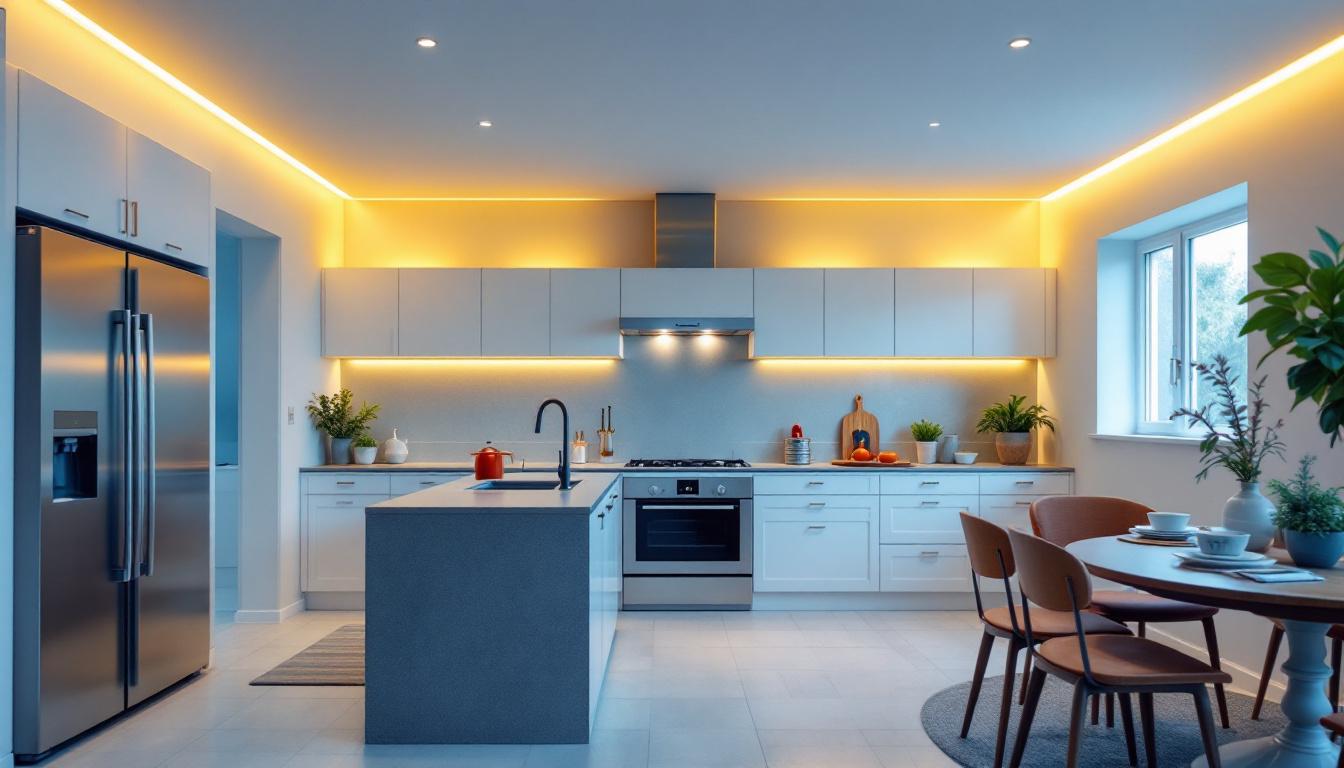
The lighting industry has witnessed a transformative shift with the advent of Light Emitting Diode (LED) technology. Initially developed for indicator lights and small-scale applications, LEDs have evolved into a dominant force in both commercial and residential lighting markets. This evolution is not merely a technological upgrade but a complete redefinition of how lighting solutions are designed, manufactured, and deployed.
For lighting contractors, understanding the trajectory of LED manufacturing is crucial. It informs decisions about product selection, installation methods, and client advisories. LEDs offer unparalleled energy efficiency, longevity, and design flexibility, making them the preferred choice over traditional incandescent and fluorescent lighting.
Traditional incandescent bulbs operate by heating a filament until it glows, a process that wastes a significant amount of energy as heat. In contrast, LEDs produce light through electroluminescence, a process that is far more efficient and generates minimal heat. This fundamental difference has driven a rapid decline in the use of incandescent and fluorescent lighting, with LEDs capturing an increasing share of the market.
Energy consumption is a critical factor for contractors advising clients on lighting solutions. LEDs consume up to 80% less energy than incandescent bulbs and can last up to 25 times longer. These benefits translate into reduced operational costs and lower maintenance requirements, which are compelling selling points in both commercial and residential projects.
Moreover, the versatility of LED technology allows for a wide range of applications, from ambient lighting in homes to specialized lighting in industrial settings. The ability to produce various colors and intensities without the need for filters or gels has opened new avenues for creative design. Architects and interior designers are increasingly leveraging this flexibility to create dynamic environments that enhance the aesthetic appeal of spaces, whether it be in retail, hospitality, or residential settings.
As the market continues to evolve, advancements in smart lighting technology are further enhancing the capabilities of LEDs. Integration with smart home systems allows for remote control and automation, enabling users to adjust lighting based on their preferences or schedules. This not only adds convenience but also promotes energy savings by ensuring lights are only on when needed. As contractors navigate this rapidly changing landscape, staying informed about these innovations will be vital for providing clients with the most effective and modern lighting solutions.
The manufacturing of LEDs has undergone significant advancements, enhancing both the quality and scalability of production. Modern LED manufacturing integrates sophisticated semiconductor fabrication techniques, precision optics, and advanced thermal management systems.
At the heart of every LED is a semiconductor chip, typically made from materials such as gallium nitride (GaN) or indium gallium nitride (InGaN). Advances in semiconductor technology have improved the efficiency and brightness of LEDs while reducing costs. Techniques like epitaxial growth and wafer-level packaging have streamlined production and improved yield rates.
For lighting contractors, these innovations mean access to LEDs with higher luminous efficacy—measured in lumens per watt—allowing for brighter light output with less energy consumption. Additionally, improved color rendering indexes (CRI) enable LEDs to produce light that more accurately reflects natural colors, enhancing the quality of lighting in various environments. The ongoing research into new semiconductor materials, such as perovskites, promises to further push the boundaries of LED performance, potentially leading to even greater efficiencies and new applications in the future.
One of the challenges in LED manufacturing is managing heat dissipation. Excess heat can degrade LED performance and shorten lifespan. Manufacturers have developed advanced heat sinks, thermal interface materials, and innovative fixture designs to address this issue. These improvements ensure that LEDs maintain consistent performance over extended periods.
Durability is another critical aspect. LEDs are solid-state devices, making them more resistant to shock and vibration compared to traditional bulbs. This robustness is particularly advantageous in industrial and outdoor applications, where lighting fixtures are exposed to harsh conditions. Furthermore, the development of protective coatings and weather-resistant enclosures has enhanced the longevity of LEDs in challenging environments, such as coastal areas with high humidity or regions with extreme temperatures. These advancements not only extend the life of the lighting systems but also reduce maintenance costs, making LEDs an increasingly attractive option for both residential and commercial applications.
The evolution of LED manufacturing has had a profound impact on the lighting market, influencing product availability, pricing, and application diversity. Lighting contractors must stay abreast of these changes to provide optimal solutions to their clients.
As manufacturing processes have become more efficient, the cost of LED products has decreased substantially. This price reduction has accelerated market penetration, making LEDs accessible for a wide range of applications, from street lighting to intricate architectural designs.
For contractors, this trend means greater flexibility in project budgeting and the ability to recommend LED solutions even in cost-sensitive scenarios. The total cost of ownership for LED lighting is often lower than traditional lighting when factoring in energy savings and reduced maintenance. Additionally, the longevity of LED products, often exceeding 25,000 hours, significantly reduces the frequency of replacements, further enhancing cost-effectiveness over time. This shift not only benefits contractors and their clients but also contributes to a more sustainable approach to lighting, as fewer resources are consumed in manufacturing and disposal.
LED manufacturing advancements have also enabled a high degree of customization. LEDs can be produced in various shapes, sizes, and colors, allowing for tailored lighting designs that meet specific aesthetic and functional requirements. Smart lighting systems incorporating LEDs offer features such as dimming, color tuning, and integration with building automation systems.
This versatility expands the scope of projects that lighting contractors can undertake, from dynamic retail environments to energy-efficient office spaces. Understanding the capabilities of modern LED products allows contractors to deliver innovative lighting solutions that enhance user experience and operational efficiency. Furthermore, the rise of tunable white LEDs has revolutionized how spaces can be illuminated, enabling environments to shift in ambiance throughout the day, which can positively affect mood and productivity. As a result, contractors are increasingly called upon to create lighting designs that not only fulfill practical needs but also contribute to the overall well-being of occupants.
Sustainability has become a driving force in the lighting industry, with LED manufacturing playing a pivotal role in reducing environmental impact. Regulatory frameworks and industry standards have further accelerated the adoption of LED technology.
LEDs consume significantly less energy than traditional lighting, contributing to lower greenhouse gas emissions when electricity is sourced from fossil fuels. Additionally, LEDs do not contain hazardous materials like mercury, which is present in fluorescent lamps, making disposal safer and more environmentally friendly.
For lighting contractors, promoting LED solutions aligns with growing client demand for green building certifications such as LEED and WELL. Incorporating LEDs can contribute valuable points toward these certifications, enhancing project marketability and compliance with sustainability goals. Moreover, the longevity of LED fixtures—often lasting up to 25,000 hours or more—means reduced maintenance and replacement costs, which not only benefits the environment by decreasing waste but also offers financial savings to clients over time.
Furthermore, the thermal management of LEDs allows for better heat dissipation, which can lead to cooler environments in commercial and residential spaces. This can reduce the reliance on air conditioning systems, further lowering energy consumption and enhancing overall building efficiency. As awareness of climate change grows, the demand for such energy-efficient solutions continues to rise, pushing the industry towards more innovative and sustainable practices.
Governments and industry bodies worldwide have implemented energy efficiency standards that favor LED lighting. These regulations often mandate minimum efficacy levels and restrict the sale of less efficient lighting products. Manufacturers have responded by optimizing LED designs to meet or exceed these requirements.
Contractors must be knowledgeable about relevant codes and standards to ensure that installed lighting systems comply with local regulations. This expertise not only prevents costly retrofits but also positions contractors as trusted advisors in the evolving regulatory landscape. Staying informed about changes in legislation, such as the latest updates to the Energy Policy Act or local energy efficiency mandates, is crucial for contractors aiming to maintain a competitive edge.
Moreover, as the industry evolves, there is a growing emphasis on smart lighting solutions that integrate with building management systems. These systems not only enhance energy efficiency but also provide real-time data analytics, allowing for better monitoring and control of energy use. By understanding and implementing these advanced technologies, contractors can further align their projects with sustainability initiatives while meeting compliance requirements, ultimately driving the industry toward a greener future.
The LED industry continues to innovate, promising further advancements that will shape the future of lighting. Emerging trends in manufacturing and technology are poised to offer even greater benefits to lighting contractors and their clients.
Smart lighting systems that leverage LEDs are becoming increasingly prevalent. These systems enable remote control, automation, and data-driven optimization of lighting environments. Advances in manufacturing facilitate the integration of sensors, wireless communication modules, and intelligent drivers directly into LED fixtures.
For contractors, the ability to offer smart LED solutions adds value and differentiates their services. It also opens opportunities for ongoing maintenance and system upgrades, creating new revenue streams beyond installation.
Research into new semiconductor materials and nanotechnology promises to enhance LED efficiency and color quality further. Additive manufacturing (3D printing) and automation in production lines are improving customization capabilities and reducing lead times.
Staying informed about these developments enables contractors to anticipate market shifts and advise clients on cutting-edge lighting solutions that maximize performance and sustainability.
The evolution of LED manufacturing has revolutionized the lighting industry, offering lighting contractors unprecedented opportunities to deliver energy-efficient, durable, and versatile lighting solutions. Understanding the technological advancements, market dynamics, and regulatory environment surrounding LEDs is essential for contractors aiming to remain competitive and meet the growing demands of their clients.
As LED technology continues to advance, lighting contractors who embrace these innovations and integrate them into their projects will be well-positioned to lead in a rapidly changing industry. The future of lighting is bright, and LEDs are at the forefront of this illuminating transformation.
As the lighting industry continues to evolve with LED advancements, LumenWholesale is here to ensure that you, the lighting contractor, have access to the finest spec-grade lighting products at the most competitive wholesale prices. Our commitment to quality and affordability means you can confidently meet your clients’ needs for energy-efficient, durable, and versatile lighting solutions. With our extensive selection that meets the highest industry standards and the convenience of free shipping on bulk orders, you’re guaranteed to find the perfect lighting options for any project. Don’t let hidden fees or inflated markups dim your potential. Wholesale Lighting at the Best Value awaits you at LumenWholesale. Light up your next project with us and experience the difference quality and value can make.

Discover the essential guide for lighting contractors on selecting the best recessed lighting for kitchens.

Discover the advantages of solar street lamps for lighting contractors, from cost savings to eco-friendly solutions.

Discover expert insights on retro vintage light bulbs tailored for lighting contractors.

Discover the latest trends in landscape lighting wire connectors that every lighting contractor should be aware of.